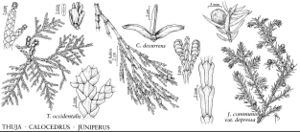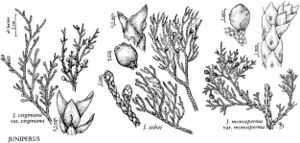Juniperus
Sp. Pl. 2: 1038. 1753; Gen. Pl. ed. 5, 461, 1754.
Shrubs or trees evergreen. Branchlets terete, 3–6 angled, variously oriented, but not in flattened sprays. Leaves opposite in 4 ranks or in whorls of 3. Adult leaves closely appressed to divergent, scalelike to subulate, free portion to ca. 10 mm (to ca. 15 mm in Juniperus communis); abaxial gland visible or not, elongate to hemispheric (J. ashei), sometimes exuding white crystalline deposit. Pollen cones with 3–7 pairs or trios of sporophylls, each sporophyll with 2–8 pollen-sacs. Seed-cones maturing in 1 or 2 years, globose to ovoid and berrylike, 3–20 mm, remaining closed, usually glaucous; scales persistent, 1–3 pairs, peltate, tightly coalesced, thick and fleshy or fibrous to obscurely woody. Seeds 1–3 per scale, round to faceted, wingless; cotyledons 2–6. x = 11.
Distribution
Primarily Northern Hemisphere, 1 in e Africa
Discussion
Juniperus is the only dioecious (sometimes monoecious) genus of Cupressaceae in the flora. Cones, generally terminal, are axillary in J. communis.
Numerous cultivars of Juniperus species are widely used for landscaping. Mutants, or "sports," affecting plant habit and foliage are present in all species and are likely related to single-gene mutations. Many have been given formal names or incorrectly ascribed to hybridization. Gymnocarpy (bare seeds protruding from the cone), caused by insect larvae (T. A. Zanoni 1978), is occasionally found in most junipers, particularly in the southwestern United States. Specimens with such aberrations may be almost impossible to identify without chemical data.
Species ca. 60 (13 in the flora).
Selected References
Lower Taxa
Key
| 1 | Leaves of 1 kind, subulate, with basal abscission zone, spreading; cones axillary (Juniperus sect. Juniperus). | Juniperus communis |
| 1 | Leaves of 2 kinds, whip (subulate, without basal abscission zone) and scalelike; cones terminal (Juniperus sect. Sabina Spach). | > 2 |
| 2 | Margins of leaves entire (at 20×) or, if with irregular teeth (at 40×), then scalelike leaves acuminate at apex. | > 3 |
| 2 | Margins of leaves denticulate (at 20×), scalelike leaves usually obtuse to acute at apex (sometimes mucronate in Juniperus deppeana or acuminate in J. monosperma). | > 6 |
| 3 | Margins of leaves with irregular teeth (at 40×), scalelike leaves acuminate at apex; seed cones with 4-13 seeds, tan-brown to brownish purple when mature; branches as well as branchlets flaccid. | Juniperus flaccida var. flaccida |
| 3 | Margins of leaves entire (at 20× and 40×), scalelike leaves obtuse to acute or apiculate at apex; seed cones with 1-3 seeds, blue-black to brownish blue when mature; branches not drooping, but branchlets often flaccid. | > 4 |
| 4 | Prostrate to decumbent shrubs; scalelike leaves apiculate at apex; peduncles generally curved. | Juniperus horizontalis |
| 4 | Upright trees; scalelike leaves obtuse to acute at apex; peduncles generally straight. | > 5 |
| 5 | Scalelike leaves not overlapping, or, if so, by not more than 1/5 their length, apex obtuse to acute; bark of larger branchlets exfoliating in plates; seed cones maturing in 2 years, of 2 distinct sizes. | Juniperus scopulorum |
| 5 | Scalelike leaves overlapping by more than 1/4 their length, apex acute (to bluntly obtuse in var. silicicola, se United States); bark of larger branchlets usually exfoliating in strips; seed cones maturing in 1 year, of 1 size. | Juniperus virginiana |
| 6 | Seed cones with 3-6 seeds, fibrous to obscurely woody; bark exfoliating in rectangular plates, branchlets erect (rarely bark exfoliating in thin strips, branchlets then flaccid). | Juniperus deppeana var. deppeana |
| 6 | Seed cones with 1-3 seeds, fleshy or resinous to fibrous; bark exfoliating in thin strips, branchlets erect. | > 7 |
| 7 | Leaves with raised hemispheric glands (particularly obvious on whip leaves). | Juniperus ashei |
| 7 | Leaves with ovate, elliptic, elongate, or inconspicuous glands (or glands round on scalelike leaves only). | > 8 |
| 8 | Seed cones blue to blue-black, with 2(-3) seeds, maturing in 2 years; bark of branchlets greater than 10 mm diam. exfoliating in scales or flakes; single-stemmed trees to 20(-30) m. | Juniperus occidentalis |
| 8 | Seed cones variously colored, but with brownish or reddish hue, even when some blue is present, with 1(-2) seeds, usually maturing in 1 year; bark of branchlets greater than 10 mm diam. usually exfoliating in strips or smooth; usually multistemmed shrubs or trees to 12 m. | > 9 |
| 9 | Abaxial glands inconspicuous because embedded in leaf; monoecious. | Juniperus osteosperma |
| 9 | Abaxial glands conspicuous; dioecious (very rarely monoecious). | > 10 |
| 10 | Seed cones mostly 9-10 mm diam., bluish brown, glaucous; branchlets about as wide as length of scalelike leaves; scalelike leaves closely appressed, abaxial surface generally flattened; branchlets terete. | Juniperus californica |
| 10 | Seed cones mostly 6-8 mm diam., reddish blue to brownish blue, rose to pinkish, or copper to copper-red, glaucous or not; branchlets ca. 2/3 as wide as length of scalelike leaves; scalelike leaves with apex spreading, abaxial surface raised; branchlets generally 3-4(-6)-sided. | > 11 |
| 11 | Seed cones reddish blue to brownish blue; fewer than 1/5 of whip-leaf glands with evident white exudate. | Juniperus monosperma |
| 11 | Seed cones rose to pinkish or copper to copper-red; 1/4 or more of whip-leaf glands with evident white exudate. | > 12 |
| 12 | Seed cones rose to pinkish, glaucous; adaxial surface of leaves glaucous. | Juniperus coahuilensis |
| 12 | Seed cones copper to copper-red, not glaucous; adaxial surface of leaves not glaucous. | Juniperus pinchotii |
"thick" is not a number.

